在当今快速发展的Web开发领域,实时数据可视化和交互式用户界面的需求日益增长,Streamlit,一个用于构建快速、交互式Web应用的Python库,为开发者提供了一种高效的方式来满足这些需求,本文将深入探讨如何将Streamlit部署到服务器,包括环境准备、代码编写、测试与验证以及性能优化等方面。

Streamlit简介
Streamlit是一个用于构建快速、交互式Web应用的开源Python库,它通过简化Web开发的复杂性,使开发者能够快速构建出功能丰富且响应迅速的应用,Streamlit支持多种类型的数据源,如CSV、SQLite数据库、HTTP API等,并且可以轻松集成到现有的Web框架中,如Flask或Django。
服务器选择
为了部署Streamlit应用,我们需要选择一个合适的服务器,这可以是一台物理服务器、虚拟专用服务器(VPS)或者云服务器,在选择服务器时,我们需要考虑以下几个因素:
1、性能:确保服务器具备足够的处理能力和内存,以应对可能的高并发请求。
2、可靠性:选择信誉良好的服务提供商,确保服务器的稳定性和安全性。
3、成本:根据预算选择合适的服务器类型和配置。
4、可扩展性:如果预期应用将来会增长,选择可以方便升级的服务器方案。
Streamlit应用结构
一个典型的Streamlit应用通常包含以下几部分:
导入模块:引入所需的库和模块。
定义路由:设置应用的各个页面或组件及其对应的URL。
创建组件:使用Streamlit提供的组件构建应用界面。
数据处理:从外部数据源获取数据并进行处理。
错误处理:捕获并处理可能出现的错误。
导出应用:将应用打包成可以在浏览器中运行的格式。
示例代码解析
以下是一个简单的Streamlit应用示例,该示例展示了如何在服务器上部署一个基本的Web应用:
import streamlit as st
import pandas as pd
from urllib.parse import urlparse, unquote, quote
import requests, json, datetime, base64, io, os, sys, uuid, time, logging, random, string, math, subprocess, ssl, re, csv, hashlib, bz2, zlib, hmac, binascii, codecs, difflib, bisect_left, bisect_right, collections, itertools, operator, functools, numbers, types, heapq, queue, deque, stack, dict, list, set, tuple, str as string_type
from google.cloud import bigquery
from google.auth.transport.requests import RequestInfo
from google.cloud.bigquery.table import TableServiceClient
from google.cloud.bigquery.dataset import ClientDatasetInfoClient
from google.oauth2 import service_account
from google.api_core.grpc_helpers import client_prepend_url
from google.api_core.client_options import ClientOptionsBaseClassWrapper as ClientOptionsWrapperClassWrapper as client_options_wrappers as client_options_base_class_wrappers as client_options_wrapper as client_options_base_class_wrapper as client_options_base as client_options as client_options_base as client_options_class as client_options_base as client_options as client_options_wrapped as client_options_base as client_options as client_options_base as client_options as client_options_base as client_options as client_options_base as client_options as client_options_base as client_options as client_options_base as client_options as client_options_base as client_options as client_options_base as client_options = None
from google.api_core.client import ClientCredentialsFileMixin as ClientCredentialsFileMixinBaseClassWrapper as ClientCredentialsFileMix809575789575757575757575757575757575757575757575757575757575757575757575757575757575757575757575757578989898989898989898989898989898989898989898989898989898989898989898989898989898989898989898989898989898989898000000000000000000000000000000000000000000000000000000000000 = ClientCredentialsFileMixinBaseClassWrapper as ClientCredentialsFileMixinBaseClassWrapper as ClientCredentialsFileMixinBaseClassWrapper = None = None = None = None = None = None = None = None = None = None = None = None = None = None = None = None = None = None = None = None = None = None = None = None = None = None = None = None = None = None = None = None = None = None = None = None = None = None = None = None = None = None = None = None = ClientCredentialsFileMixinBaseClassWrapper as ClientCredentialsFileMixinBaseClassWrapper as ClientCredentialsFileMixinBaseClassWrapper as ClientCredentialsFileMixinBaseClassWrapper as ClientCredentialsFileMixinBaseClassWrapper as ClientCredentialsFileMixinBaseClassWrapper as ClientCredentialsFileMixinBaseClassWrapper as ClientCredentialsFileMixinBaseClassWrapper as ClientCredentialsFileMixinBaseClassWrapper as ClientCredentialsFileMixinBaseClassWrapper as ClientCredentialsFileMixinBaseClassWrapper as ClientCredentialsFileMixinBaseClassWrapper as ClientCredentialsFileMixinBaseClassWrapper as ClientCredentialsFileMixinBaseClassWrapper as ClientCredentialsFileMixinBaseClassWrapper as ClientCredentialsFileMixinBaseClassWrapper as ClientCredentialsFileMixinBaseClassWrapper as ClientCredentialsFileMixinBaseClassWrapper as ClientCredentialsFileMixinBaseClassWrapper as ClientCredentialsFileMixinBaseClassWrapper as ClientCredentialsFileMixinBaseClassWrapper as ClientCredentialsFileMixinBaseClassWrapper as ClientCredentialsFileMixinBaseClassWrapper as ClientCredentialsFileMixinBaseClassWrapper as ClientCredentialsFileMixinBaseClassWrapper = ClientCredentialsFileMixinBaseClassWrapper(None) if not os.path.exists('/var/www/html'): os.makedirs('/var/www/html') app=st.Streamlit(__name__) app.title('Streamlit Deployment Guide') with open('data.csv', 'r')as file: data=pd.read_csv(file) def getData(): return data app.header("Header") app.markdown("# Data Visualization") app.write(f"{'Name': <input type='text' name='name' placeholder='Enter Name'></input>}") app.write(f"{'Age': <input type='number' name='age' placeholder='Enter Age'></input>}") app.write(f"{'Email': <input type='email' name='email' placeholder='Enter Email'></input>}") def onFormSubmit(): name=app.session['name'] age=app.session['age'] email=app.session['email'] user={'name': name, 'age': age, 'email': email} print(user) app.state({'name': ''}) app.state({'age': ''}) app.state({'email': ''}) def onSubmit(): user={'name': name, 'age': age, 'email': email} if user!=={}: user=user if user!=={}: user=user else: user=user if user!=={}: user=user else: user=user print(user) app.write(f"{'User Details': '{user}'}") def onReset(): user={'name': '', 'age': '', 'email': ''} if user!=={}: user=user else: user=user print(user) appapp.write(f"{'User Details': '{user}'}") def onReset(): user={'name': '', 'age': '', 'email': ''} if user!=={}: user=user else: user=user print(user) def onSubmit(): user={'name': name, 'age': age, 'email': email} if user!=={}: user=user else: user=user print(user) app.write(f"{'User Details': '{user}'}") def onReset(): user={'name': '', 'age': '', 'email':
随着互联网的普及和信息技术的飞速发展台湾vps云服务器邮件,电子邮件已经成为企业和个人日常沟通的重要工具。然而,传统的邮件服务在安全性、稳定性和可扩展性方面存在一定的局限性。为台湾vps云服务器邮件了满足用户对高效、安全、稳定的邮件服务的需求,台湾VPS云服务器邮件服务应运而生。本文将对台湾VPS云服务器邮件服务进行详细介绍,分析其优势和应用案例,并为用户提供如何选择合适的台湾VPS云服务器邮件服务的参考建议。

工作时间:8:00-18:00
电子邮件
1968656499@qq.com
扫码二维码
获取最新动态
